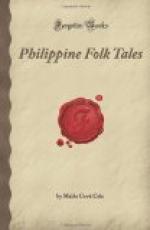[94] The Bukidnon of Mindanao have the following story: During a great drought Mampolompon could grow nothing on his clearing except one bamboo, and during a high wind this was broken. From this bamboo came a dog and a woman, who were the ancestors of the Moro. See “The White Squash,” note 1, p. 186.
[95] At the north end of the village of Mayinit are a number of brackish hot springs, and from these the people secure the salt which has made the spot famous for miles around. Stones are placed in the shallow streams flowing from these springs, and when they have become encrusted with salt (about once a month) they are washed and the water is evaporated by boiling. The salt, which is then a thick paste, is formed into cakes and baked near the fire for about half an hour, when it is ready for use. It is the only salt in this section, and is in great demand. Even hostile tribes come to a hill overlooking the town and call down, then deposit whatever they have for trade and withdraw, while the Igorot take up the salt and leave it in place of the trade articles.
[96] The women of Samoki are known as excellent potters, and their ware is used over a wide area. From a pit on a hillside to the north of the village they dig a reddish-brown clay, which they mix with a bluish mineral gathered on another hillside. When thoroughly mixed, this clay is placed on a board on the ground, and the potter, kneeling before it, begins her moulding. Great patience and skill are required to bring the vessel to the desired shape. When it is completed it is set in the sun to dry for two or three days, after which it is ready for the baking. The new pots are piled tier above tier on the ground and blanketed with grass tied into bundles. Then pine bark is burned beneath and around the pile for about an hour, when the ware is sufficiently fired. It is then glazed with resin and is ready to market.
[97] The mythology of nearly all peoples has a flood story. For the Tinguian account see note on page 103. For the Bukidnon story see p. 125.
[98] A bamboo basket, in which the heads of victims are kept prior to the head-taking celebration.
[99] The folk-lore of all countries has some story accounting for the acquisition of fire. The Tinguian tale is as follows: Once in the very old times Kaboniyan sent a flood which covered all the land. Then there was no place for the fire to stay, so it went into the bamboo, the stones, and iron. That is why one who knows how can still get fire out of bamboo and stones.
[100] See note 1, p. 99.
[101] The magical increase of food is a popular subject with the Tinguian, appearing in many of their folk-tales. See note 2, p. 48.
[102] Note the similarity to the story of Moses in this account of Lumawig striking the rock and water coming out. There is a possibility that this incident was added to the story after the advent of the Catholic missionaries.




